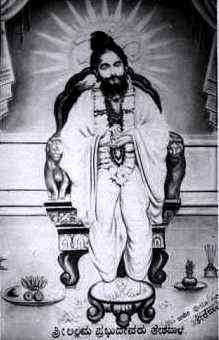Shri Allama Prabhu
Prabhu, who is otherwise known as Allama, Allaya, Allama Prabhu or Prabhudevaru, was probably born in the very beginning of the 12th century. He is perhaps the most important leader of the Vīraśaiva (Śaivism of Karnataka) Movement along with Basaveśvara.
The exact date of his birth is neither known nor has it been ascertained by any of his biographers. Prabhu was born in Ballegavi, a village near Banavasi to Nirahankara and Sujnani Karavura (in the Shimoga district of Karnataka). Ballegavi was set in the midst of palm trees, water-pools and rice fields.
The temple of Goggeshwara or Guheshwara adorned this inspiring setting. His parents, Nirahaṅkāra and Sujñāni, were a devout couple and Goggeshwara was their family deity. Sujñāni had often visitations from God, Goggeshwara, in her dreams. Nirahaṅkāra was the head of a dance school and was well versed in three branches of music. But a secret longing was gnawing at their hearts. It was the longing for a child. In her daily prayers, Sujnani appealed to God to bless her with a child. One day she dreamt that she had been possessed by God. In the temple opposite her house the image of Shiva quickened to life under her own eyes. A ray of light penetrated to the depth of her being. In the course time, she conceived and gave birth to a child. The child, whom the world was to know as the Vairagya Chakravarti (the supreme renunciate) was named Prabhu.
Prabhu, showed extraordinary spiritual wisdom and maturity even as a child. His artistic temperament and prowess were revealed when he was only six years old. He had inherited from his father's artistic temperament. A passionate instinct for the beautiful was the first channel which brought him in contact with God. But there was a rich undercurrent of asceticism which occasionally peeped through his demeanor. The mutually conflicting instincts for the artistic and the ascetic and for the beautiful and sublime struggled within him for supremacy. According to one biographer Hari-hara, he was married in his youth to one Kāmalatā, but renounced the world when she died at a young age. In the end, the ascetic instinct got the upper hand and turned him into a renowned 'renunciate'.
Another incident mentioned is his ‘conquest of Māyā,’ Māyā being a princess who fell in love with him. He successfully resisted her advances and continued his onward spiritual journey. It is perhaps this experience that is at the root of his vacana (lyrical prose composition). ‘Māyā is not in woman, but in the eye that beholds her.’ His intense desire to get enlightenment took him to a highly competent guru (spiritual teacher) Animiṣayya sitting in a guhā (cave). It was by his grace that he was filled with Śiva-consciousness and bliss. Hence he has used the pen-name ‘Guheśvara’ in his compositions.
He is said to have enlightened Gorakhnāth (another famous medieval saint) and many śivaśaraṇas (Vīraśaiva saints) like Basava, Siddharāma, Muktāyakka, Akka Mahādevi, Goggayya and others. His vacanas are a class by themselves and have successfully expressed deep spiritual experiences through wonderful similes.
References[edit]
References[edit]
- Shri Allama Prabhu
- The Concise Encyclopedia of Hinduism, Swami Harshananda, Ram Krishna Math, Bangalore

